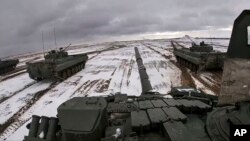Top Russian commanders arrived in neighboring Belarus on Wednesday, set to oversee 30,000 Russian troops as they train for 10 days with the Belarusian military in the latest show of Moscow’s force along the Ukrainian border.
Russia has moved two battalions of S-400 surface-to-air missile systems and numerous fighter jets into Belarus for the exercises, with Gen. Valery Gerasimov, the chief of the Russian armed forces’ General Staff, in command of the drills that start on Thursday.
The training in Belarus is the latest threat to Ukraine, whose capital Kyiv sits just 210 kilometers to the south. Moscow has also deployed warships to the Black Sea and amassed more than 100,000 troops along Ukraine’s eastern flank.
The Kyiv government announced its own 10-day military exercises, also starting Thursday, using unmanned aircraft and antitank missiles supplied by Ukraine’s Western allies.
Kremlin spokesman Dmitry Peskov said Russia was staging the joint exercises with Belarus to combat “unprecedented security threats.”
“Russia and Belarus have encountered unprecedented threats, the nature and, perhaps, concentration of which are, unfortunately, much larger and much more dangerous than before,” Peskov told reporters.
Western intelligence experts say they believe Moscow has about 70% of its strike force in place for an attack on its one-time Soviet republic, which that has leaned to the West in recent years and seeks to join NATO, the Western military alliance formed after World War II.
Russian President Vladimir Putin has denied he plans to invade Ukraine but demanded that the West reject the possibility of Ukraine joining the 30 countries already in NATO and that the Western allies pull back their troops and armaments closest to Russia.
In response, the West has said Russia has no veto power over who belongs to NATO but that it is willing to negotiate with Moscow over the placement of missiles in eastern Europe and periodic NATO military drills.
French President Emmanuel Macron’s talks Monday with Putin, and on Tuesday with Ukrainian President Volodymyr Zelenskiy, did not appear to significantly ease tensions or the possibility of an invasion.
“You must not underestimate the tension that surrounds the situation that we are living through, its unprecedented nature,” Macron said in Kyiv. “I do not believe this crisis can be solved thanks to a few hours of discussions.”
Russian Deputy Foreign Minister Sergei Ryabkov said Wednesday that “everything else depends” on whether the United States and NATO are willing to negotiate seriously on Russia’s demands. He contended that NATO’s document responding to Russia showed “rudeness and defiant language.”
Meanwhile, the parliament in Slovakia, a NATO member, on Wednesday approved a defense military treaty with the United States, similar to pacts Washington has with other NATO allies.
The treaty, signed by U.S. Secretary of State Antony Blinken last week, allows the U.S. military to use two Slovak air force bases for 10 years while Slovakia will receive $100 million from the U.S. to modernize them.
Slovakia’s prime minister, Eduard Heger, said the treaty will “significantly enhance our security,” although his opponents claim it would compromise the country’s sovereignty.
In agreeing to the deal, Blinken said it would not create permanent U.S bases or a permanent troop presence in Slovakia.













